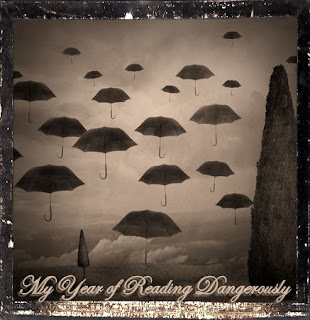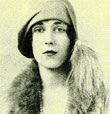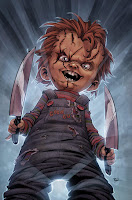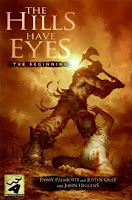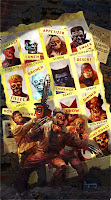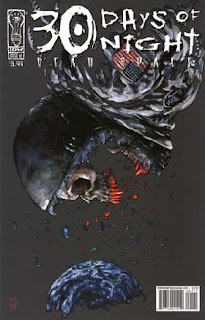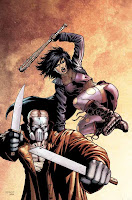By
Jodie Reading, uninterrupted for 24 hours; I think most of us would agree that sounds like a fantastic plan. But do we ever put this grand design into practice? Find an activity guaranteed to occupy the kids, partner or pet for the day and your mental task list will simply bump some sort of drudgery to the top spot. You begin
Madame Bovary but remember that the washing needs hanging or there’s a presentation due at work and the mental priority light just keeps blinking, perhaps the blinking is even accompanied by bleeps. Bovary is doomed.
One woman has come to save us from ourselves. Dewey (
http://deweymonster.com/) has just hosted the 24 hour Read-a-thon, where everyone was encouraged to abandon those annoying responsibilities temporarily to be able to concentrate on reading. Dewey woke up just in time to answer my questions:
JB: What prompted the challenge?
D: My husband and son participate in the 24 Hour Comics Day (
24hourcomics.com) and one day I jokingly said that next time they did that, I would just read for 24 hours. My husband suggested that I get some blog-friends to join me, and that led to the idea of setting it up as a challenge anyone could join. Our Read-a-thon was the same day as 24 Hour Comics Day, so I included a comic-creating mini-challenge.
JB: What makes your project stand out from the many outstanding challenges that have been organized this year?
D: Most reading challenges in the blogosphere involve reading a certain number of books, in a certain amount of time, about a certain topic. The 24 Hour Read-a-thon was about marathon reading as well as blogging and visiting other participants. I love reading challenges, but this had a very different feel. It started to seem like a sleepover, and I think the participants made new friends and got to know old friends better.
JB: Have you taken part in other people's book challenges this year?
D: Oh yes! Right now I'm participating in The Newbery Challenge, the New York Times Notable Books Challenge, the Something About Me Challenge, the R.I.P. II challenge, the Book Awards Reading Challenge, the Unread Authors Challenge, and the Pulitzer and Newbery projects, which are unlike most challenges in that they have no end date. I'm also already committed to participating in three or four challenges in 2008.
JB: Roughly how many people participated in the challenge?
D: About 50. Some were Readers, some were Cheerleaders, some were both, and some donated prizes.
JB: What did you read on the day?
D: I was actually surprised at how little time I had to read. I only ended up reading about half of Neil Gaiman's
Stardust. The organizing and communicating with participants took nearly all my time the whole 24 hours.
JB: Why did you include mini-challenges throughout the day? What was the most popular mini-challenge?
D: I included mini-challenges (and cheerleaders as well) because I didn't want the readers to feel isolated. I'm really interested in building community, and that's what the Read-a-thon was all about. I knew that Readers would need breaks, so I took advantage of that to get them interacting with each other. They were all either creative activities or community-building activities, and different participants preferred different mini-challenges. I was impressed by what great sports the Readers were; some of them did nearly all the mini-challenges, even when they were exhausted way at the end.
JB: What book related day would you like to see made a world wide holiday?
D: Buy A Friend A Book Week!
http://www.buyafriendabook.com/JB: What would your ultimate type of book be (fact/fiction, long/short, genre, author gender etc.)?
D: I have really eclectic tastes and read nearly all genres, but I read a lot more fiction than nonfiction, and my main interest is in what's known as literary fiction. My ultimate type of book would be one I could reread every year and still keep finding something new to love.
JB: What are currently your favourite books?
D: Some recent books I've loved are
March by Geraldine Brooks,
The Invention of Hugo Cabret by Brian Selznick,
Half of a Yellow Sun by Chimamanda Adichie, and
The Penelopiad by Margaret Atwood. (You might want to double check my spelling on some of those names.)
JB: Will you be running the challenge again next year?
D: I hope so!
Some participants decided they’d love to share their experiences of living the decadent, bibliophile lifestyle prescribed by Dewey.
Heather: (
http://www.errantdreams.com/thoughts/) “I decided to participate in Dewey’s Read-a-thon because I’m way behind on my review book reading and it just sounded like a ton of fun. Usually I’m too busy to participate in all the blog-based reading challenges, but I thought that one day was something I could commit to.”
Eva: (
http://astripedarmchair.blogspot.com/) “…I highly recommend that everyone who can clear their schedules next year participate! Although I loved the reading, and the prizes, my favourite part was the community building that went on.”
Callista: (
http://smsbookreviews.blogspot.com/) “I finished the last little bit of
Mosaic by Amy Grant, read 3/4 of
Black Creek Crossing by John Saul, almost finished
First Times Compiled by Marthe Jocelyn and read completely
The Giver by Lois Lowry,
fake id by Hazel Edwards and
The Great Number Rumble by Cora Lee and Gillian O'Reilly.”
Stephanie: (
http://somanybooksblog.com/) “I read three different books and journal articles for school. I completed one book and all the journal articles.”
Iliana: (
http://www.bookgirl.net/) “I had such a great time participating even though my hours read is actually a very small number - 5! …What I didn’t expect was to do as much blog hopping throughout the day but it was addicting to see how the readers were doing.”
Read-a-thon BloggedHour OneEva: “Whew-Tithe was definitely a good choice to start off with; I'm racing through it. An interesting plot, plus big type and small pages make me feel like I'm really achieving something! At first, I was turned off by the writing style (not as polished as I would've liked), but once I relaxed I found myself enjoying the story enough to overlook it.”
Callista: “I'm really going to try for all 24 hours but I had the worst nights sleep ever last night so I might crash sitting up with the book in my hands. I'll read walking if I have too and I have some pop.”
Heather: “I have my coffee in-hand (very important prerequisite). I don’t have a set agenda for what I’ll read, but here’s what I’m thinking so far… I may focus on some of the shorter books in an effort to feel a sense of accomplishment by shortening that list, but I will probably also alternate that with reading sections of The Gift of Rain, which is a beautiful book but a bit of a slow read for me.”
Hour TwoStephanie: “From the comments I see the cheerleaders are already out in force! I read Lord of the Flies for about 45 minutes before I had to stop. My Bookman, who is semi-joining me in the reading day, and I had to go to the grocery store. The cupboards were bare and we needed real food and a little treat to sustain us through the afternoon.”
Hour ThreeEva: “This hour, I finished up Tithe; I'm uncertain as to whether to award it three or four stars. Parts of it were very good, other parts not so much. Overall, I'd recommend it for people who enjoy urban fantasy, and don't mind a somewhat clunky writing style and teens who engage in sketchy behaviour (lol-like sixteen-year-olds smoking and hooking up). After I was done with that, I decided I wanted a complete change of pace, so I went with The Kitchen Boy, a historical novel by Robert Alexander set in Russia when it was becoming the USSR. It recounts the last days of the Russian royal family's lives.”
Hour FiveCallista: “Cool challenge! Read a book in another language. I'm reading: La Escalera Misteriosa by Edith Checa”
Iliana: “An Infamous Army is on hold while I read a short story from Leyendas Mexicanas. A book of creepy little tales in Spanish.”
Heather: “I just spent an entire chapter inside the head of a sort-of British gangster who wants to think he has class, as he interior monologued in most outrageous and hysterical fashion about everything from Pre-Raphaelite paintings to the morality of a morning shag in the living room with the curtains open. I couldn’t stop laughing the whole way through.”
Hour SixStephanie: “My shoulders are killing me. Next year’s Read-a-Thon should include massages. I’ll have to be nice to my Bookman, I’m sure he’ll oblige me.”
Hour EightStephanie: “Charged up with coffee and a yummy snack I read nonstop for close to two hours. My shoulders feel better, but now my legs are starting to ache from sitting so much so it’s time for a little break. A nice walk with my Bookman and the dog. Oh, and Lord of the Flies is fantastic! The tension is really getting to me and I think I held my breath over the last two pages I read!”
Hour Ten:
Dewey: “I am getting really restless. This next hour, I am definitely going to take my own advice and go outside for a walk… I’ve been mostly reading this hour, and I can’t shake the feeling that I’ve read Stardust. It’s older than I thought, published in 1999.”
Stephanie: “The walk was nice… More reading after the walk…I’m a slow reader, so only find myself about 3/4 of the way through Lord of the Flies. It just got creepier and the tension level went up another notch! Oy, it’s nerve wracking. I had begun the book earlier in the week during lunch but didn’t get far. I am sort of glad because this reading in one intensive swoop is fun. Even with short breaks the tension that builds doesn’t wane because I haven’t forgotten where I was when I pick the book back up. Plus Golding is such an amazing writer I get sucked back to the island as soon I start to read.”
Iliana: “Had a good time at Half Price Books even though I didn’t buy any books. Shocking isn’t it? I also read another short story, The Romance of Certain Old Clothes by Henry James. This is my first intro to Henry James and now I’d love to read more of by him.”
Hour Twelve Callista: “The Giver is a re-read for me. It is one of my favourite books if not THE favourite. My headache is gone and I'm not as tired as I was.”
Hour ThirteenDewey: “My Hour 13 did not go very well. I did no reading at all, but I did visit a few Readers. Here’s what happened.
Husband: (puts pizza into oven) …(time passes)
Me: (sniffs) Could you check the pizza? It smells done.
Husband: No, because the instructions say 15 to 21 minutes, and it’s only been 9.
My phone: Ring! Ring ring! Me: (talking to co-worker 3 min 7 sec)
Entire House: (FILLS WITH SMOKE!)
Me: (to coworker) I HAVE TO GO! BYE!
Me: THE PIZZA IS BURNING! LOOK AT THE SMOKE!
Husband: Oops.
Smoke alarm: SCREEEEEEEEEEEEEEECH!!!!!!!!!!
Pizza: (Sits around being all black.)”
Hour FourteenDewey: “This hour, I really started to notice the participants bonding with each other. People who just met through the read-a-thon are really getting to know each other. And I know that I feel like I’m getting to know people better, too, even those I already did know.”
Eva: “I'm absolutely loving the mini-challenges! Wow-these cheerleaders are super-inventive. :) This hour, I'm supposed to decide what I would serve at a book group meeting to discuss one of the books I've been reading. I just finished Gods in Alabama (and it was a great read!), but I also really want to talk about Russian food, so I'm going to do two version! First, let's say we're meeting for Gods in Alabama, a book about the South. Since we're talking about finger food, I'd probably serve fried chicken and cornbread with sweet sun tea and some kind of pie for dessert. :) Glorious! For The Kitchen Boy, I'd serve black tea with guest's choice of sugar, lemon, and raspberry preserves, along with blinchiki.”
Hour FifteenIliana: “I’ve started two books since I last checked in. An Infamous Army is quite good but I thought if I added a couple of other books it’d help to keep things a bit more exciting during the read-a-thon. One book is Season of the Witch by Natasha Mostert, which is my fourth R.I.P. II Challenge book, and the other is The Sewing Circles of Herat by Christina Lamb which I’m reading for a book group.”
Dewey: “I started to get giddy this hour, having animated conversations with the cat (who did not appreciate it), marching around the living room singing La Marseillaise at the top of my lungs to wake myself up, and just in general annoying my husband…Having animated conversations with the cat is not really very unusual for me, but I rarely sing bloodthirsty anthems, and I never march.”
Hour SeventeenIliana: “I slacked off a bit between 10 and 12 but have started reading again. I think I can still stay up for another hour or so but am not making any promises.”
Eva: “Wow! I'm completely and utterly sucked in by the world of Marked. There are definitely some things I would change about it stylistically, but I award it an A+ for keeping me awake.”
Hour Twenty One
Stephanie: “Well, I’m awake… I thought I’d attempt to begin these last few read-a-thon hours with an in progress book, A Life of One’s Own: A Guide To Better Living Through the Work and Wisdome of Virginia Woolf. I’m not sure Virginia would recommend being up this early. And I’m not sure non-fiction is the way to start the day, but I’ll give it a go. If it doesn’t work I have poetry by Rumi as well as The Odyssey and if all else fails I will start reading some fiction.
Hour Twenty FourStephanie: “The dog is still snoring. The Odyessey made good reading this last hour. Odysseus met the Cyclops, and you probably know the story. Pretty gruesome descriptions in the poem. They had a couple other adventures and now are down to one ship. They have just reached Circe’s island. It is clear that the reserved strategist from The Iliad has turned into a real jerk. Maybe he was always like that, or maybe ten years of war have addled his brain.”
Eva: “Mugs of Hot Tea: 4
Mugs of Hot Chocolate: 2
Glasses of Iced Tea: 3
Cans of Diet Pepsi: 1
Reading over 2,000 pages in 24 hours: Priceless!”
You can read all about Dewey’s challenge by visiting her blog and reading the fun surveys she made for the participants, which each posted at their website.


